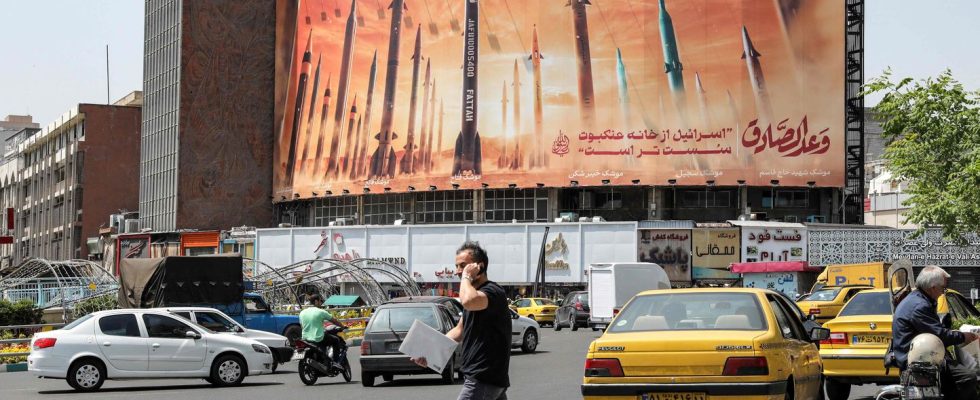It’s a term that we’ve seen popping up in the mouths of many Middle East specialists since Iran’s attack on Israel. Three days after the sending of 200 drones and missiles to Hebrew territory, observers discuss the not always clear role of Iran’s “proxies”. Behind this term actually hides a multitude of allies that the Islamist republic uses to carry out attacks against its enemies. With a common desire to hurt Israel and its American supporters, these armed militias from Lebanon, Iraq, Syria and Yemen serve as Iran’s armed wing. But why and in what interest? 20 minutes takes stock of the role of these “proxies”, which could contribute, or not, to the much feared escalation in the Middle East.
What is a “proxy” and what is it for?
During the night from Friday to Saturday, more than 200 drones and missiles converged on Israel. The damage caused by this attack is limited, in particular because the Jewish state claims to have destroyed 99% of the devices, showing in the process the effectiveness of its air shield. For Iran, the objective was obviously not to do too much damage, with the fear of triggering a frontal war with Israel. No, that wasn’t the important thing. By targeting its neighbor, the Islamist republic first wanted to respond to an attack perpetrated by its enemy on its consulate in Damascus (Syria) on April 1. Strikes attributed to the Israeli army which clearly aimed to destabilize the “axis of resistance” in which several armed groups of Shiite faith such as the Lebanese Hezbollah but also Sunni groups such as the Syrian Hamas are allied.
Among these allies of the “axis of resistance”, Iran has several “proxies”. These armed militias come to support him, responding to his orders. But in what interest? “Because Iran finances them and supplies them with weapons. A good part of the money from oil exports is used to finance these support groups,” explains Azadeh Kian, Franco-Iranian sociologist, professor at the University of Paris.
According to this specialist, if Iran has so many unofficial allies, it is above all to compensate for its diplomatic isolation. Unlike its neighboring countries, it has almost no support among world leaders. “A proxy is commonly recognized as an agent acting, in exchange for support, particularly material, on behalf of an actor mainly external to a conflict,” writes Arthur Stein, analyst at the Institute of Advanced National Defense Studies. In this country which alone brings together 40% of the world’s Shiite population, we have therefore learned to get closer to armed militias to weigh. “The regimes of other Arab countries are very careful not to attack Iran, because they may fear reprisals on their territory from organized groups capable of destabilizing them.” In a long work entitled “Iran and proxies in the Middle East”two researchers from the French Institute of International Relations discuss the “nuisance capacity” of these armed groups that are difficult to control.
Who are these friendly and allied proxies of Iran?
It is quite difficult to draw up an exhaustive list of proxies of the Iranian regime even if several names emerge. “A complex network of armed groups”, according to Arthur Stein’s analysis. Among the unwavering supporters, we can cite the Lebanese Hezbollah, the first to congratulate its ally on this attack. “It was Iran that participated in its creation after the Islamic revolution of 1979,” recalls Azadeh Kian. Little by little, the political party shed its most moderate leaders for more radical elements, determined to wage war on Israel. Hezbollah is considered by many to be a terrorist organization, but not by Iran, which refutes this designation. But for the Franco-Iranian sociologist, it is rather her Iraqi branch which must be considered as a real “proxy”. “Kataeb Hezbollah are the most loyal. We saw it when they attacked an American base (which left three people dead in January, near the border between Jordan and Syria). The others are not at Iran’s command from morning to evening. They have their own agenda.” And are freer.
Among Iran’s other proxies, we can also cite the Houthis of Yemen, to whom the Tehran regime regularly provides drones and weapons, in exchange for its “loyalty”. In this list, we can add Iraqi Shiite armed factions. And sometimes even Hamas and Palestinian Islamic Jihad. Subservient armed groups that make the entire earth tremble. “The Iranian strategy of supporting armed groups across the region has long been perceived by the adversaries of the Islamic Republic as a blatant case of support for international terrorism,” assure Morgan Paglia and Vincent Tourret in their research.
Why do they raise fears of a conflagration?
In an ultra-tense context due to the clashes between Israel and Hamas, the attitude of proxies is closely scrutinized. Firstly because they are subservient and therefore married to no agreement. But above all because they can offer Iran multiple possibilities to attack while saying “it’s not me”. In their study published in 2020, researchers from the French Institute of International Relations believe that Iran is pursuing “an indirect and subversive strategy allowing it to carry out offensive actions while benefiting from plausible deniability of its responsibilities, and thus avoiding a perilous escalation”.
More information on the Iran-Israel conflict
Faced with the risk of conflagration, the Tehran regime could be tempted to increasingly call on its armed forces to do “the dirty work” for it. An attitude which will undoubtedly depend on Israel’s response to this attack which is not very destructive but which constitutes a first because it was carried out directly by Iran. “This is what worries me, especially when we know the Israeli military means,” fears Azadeh Kian. Until now, countries waged war against each other through intermediary groups. There, it became frontal, direct. The consequences could be devastating. »

